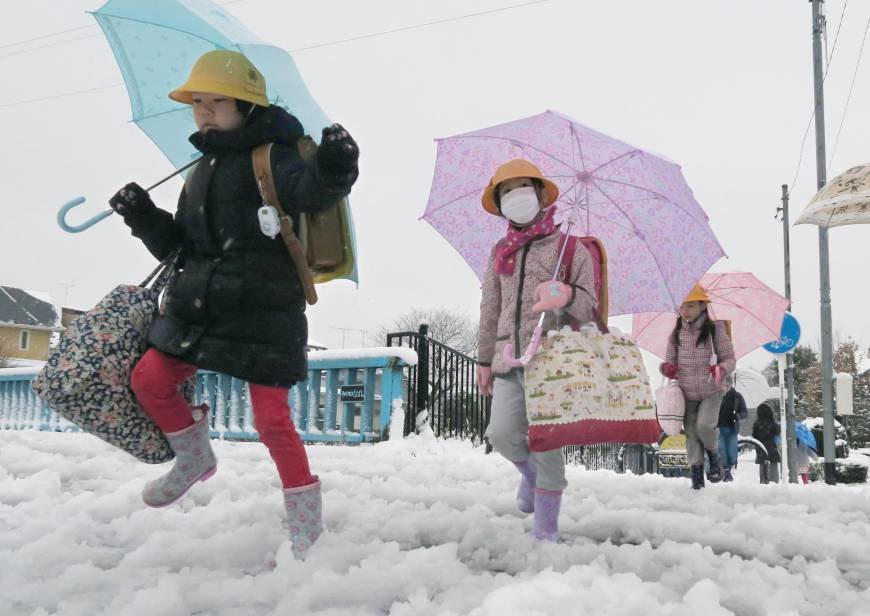
© KYODOChildren walk to school amid heavy snowfall in Chofu, western Tokyo, on Monday morning
Heavy snow in eastern and northeastern Japan wreaked havoc with transportation systems and injured about 250 people Monday as central Tokyo was blanketed with 6 cm.
At least 40 people were sent to hospitals in Tokyo alone, and another 30 were reported injured in Saitama Prefecture, police and fire departments across the region said.
Over the 24 hours through 6 p.m. Tuesday, up to 100 cm of snow is forecast to fall in Hokkaido and the Hokuriku region, 70 cm in the Tohoku and Tokai areas, 50 cm in the Chugoku region, and 40 cm in the Kanto and Koshin regions, according to the Meteorological Agency.
The low-pressure system responsible for the snow was predicted to remain through Tuesday, especially along the Sea of Japan coast.
The land ministry urged people to prepare for heavy snow in the affected areas and refrain from going out unless necessary. Snow tires and chains for cars were also recommended.
The snow temporarily brought services on the Joetsu and Hokuriku shinkansen lines to a crawl, affecting approximately 30,000 passengers, while a slowdown of services on the Tokaido Shinkansen Line inconvenienced around 11,000 people.Japan Airlines Co. and All Nippon Airways Co. cancelled 197 domestic flights in total, affecting more than 16,000 people.The Chuo Expressway was closed in some areas of Nagano and Yamanashi prefectures.
East Japan Railway Co. also canceled some express and local trains on the Chuo and Oume lines.
In Suginami Ward, Tokyo, a minivehicle overturned and the driver, a man in his 60s, suffered a broken right arm. In Chikusei, Ibaraki Prefecture, a 22-year-old man injured his head after his car slipped and collided with an oncoming truck, police said.
Unaccustomed to the snow and ice, many people in urban areas suffered minor injuries in falls. Thousands of morning rush-hour commuters were stuck on crowded station platforms or aboard trains as the weather disrupted the rail network.
Brimming with passengers waiting to board trains, people were seen unable to pass through ticket gates at Shinjuku, Shibuya and other major stations.
Even the normally subdued Motohasunuma Station on the Toei Mita Line in Itabashi Ward, Tokyo, was packed with commuters waiting for trains at around 9 a.m.
The line reduced the number of operating trains, causing delays of roughly 60 minutes.
"I just called my company that I won't make it to the office in time," a male employee in his 30s said in a resigned tone while waiting for a train he could squeeze into. "I've already passed over four consecutive trains but still can't get on. ... This is amazing."
On the Keio Inokashira Line, the usual 15-minute commute from Mitakadai to Shibuya Station took nearly 75 minutes after the operator halted express services and reduced the number of trains.
The disruptions also forced a group of young female travelers from Yamagata Prefecture at JR Shinagawa Station to look for alternatives to their plans.
"We were hoping to visit the Studio Ghibli Museum (showcasing the anime of Hayao Miyazaki) in Mitaka (western Tokyo), but we assumed it would take too much time to get there," a 25-year-old woman said. "We were just discussing how best to spend our time here as we have to go back home today."
A 50-year-old American man in Tokyo for a business trip, said as he was heading to JR Osaki Station he was surprised to see such heavy snow in the capital.
"It's scary. I've been to Japan many times, but I've never seen something like this," he said.
Reader Comments
to our Newsletter